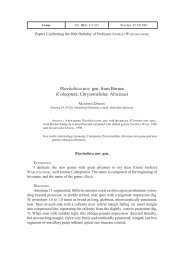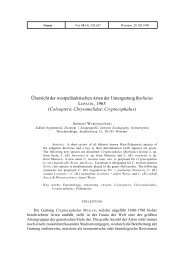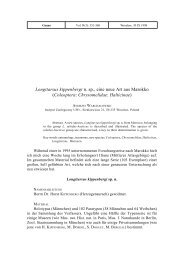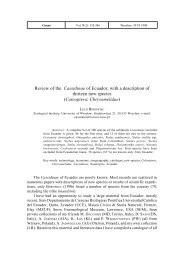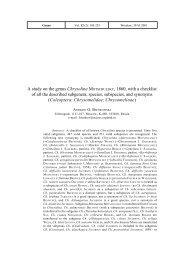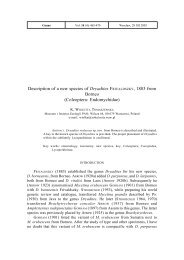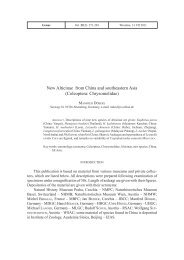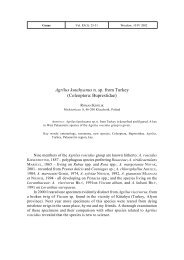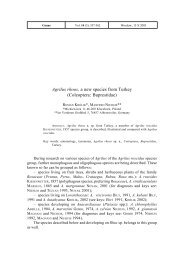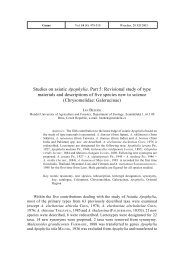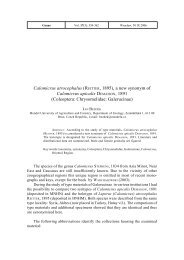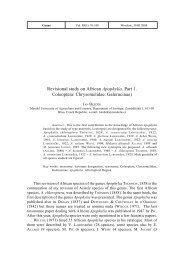New records of Asian and Australopapuan Cassidinae, with a ...
New records of Asian and Australopapuan Cassidinae, with a ...
New records of Asian and Australopapuan Cassidinae, with a ...
Create successful ePaper yourself
Turn your PDF publications into a flip-book with our unique Google optimized e-Paper software.
NEW RECORDS OF ASIATIC AND AUSTRALOPAPUAN CASSIDINAE 545<br />
DESCRIPTIONS OF NEW SPECIES<br />
Cassida dembickyi n. sp.<br />
Etymology<br />
Dedicated to Czech collector L. DEMBICKY.<br />
DIAGNOSIS<br />
Regularly convex elytral disc, simple claws <strong>and</strong> almost wholly black pronotal<br />
<strong>and</strong> elytral disc place this species close to Cassida probata SPAETH <strong>and</strong> its<br />
relatives. The group comprises also Cassida subprobata (CHEN et ZIA),<br />
C. mroczkowskii BOROWIEC et ŒWIÊTOJAÑSKA, <strong>and</strong> two species described below –<br />
C. chiangmaiensis n. sp. <strong>and</strong> C. paiensis n. sp. C. subprobata distinctly differs in<br />
yellow abdomen, <strong>with</strong> the only first sternite <strong>with</strong> black margins or spots (in<br />
C. dembickyi abdomen in middle is black). C. mroczkowskii differs in sparse<br />
punctuation <strong>of</strong> elytral sides <strong>with</strong> distance between punctures partly as wide as to<br />
slightly wider than puncture diameter (in C. dembickyi punctuation is dense,<br />
punctures almost touching each other). C. paiensis <strong>and</strong> C. probata differ in<br />
infuscate last two to four antennal segments (in C. dembickyi antennae are<br />
uniformly yellow, or only apex <strong>of</strong> the last segment is slightly infuscate).<br />
C. chiangmaiensis is the most similar, especially by its uniformly yellow antennae,<br />
but differs in larger size (length 5.25-5.5 mm, in dembickyi 4.6-4.95 mm),<br />
angulate pronotal sides (in dembickyi narrowly rounded), black on elytra in<br />
humeral area extending only to submarginal row (marginal row in C. dembickyi),<br />
<strong>and</strong> abdomen broadly margined by yellow (in C. dembickyi narrowly margined).<br />
Dark form <strong>of</strong> Cassida variablis (CHEN et ZIA) <strong>with</strong> black disc <strong>of</strong> pronotum <strong>and</strong><br />
elytra is also similar but differs in completely yellow ventrites. Cassida flavoscutata<br />
SPAETH is at first glance very similar to C. dembickyi but belongs to the species<br />
group <strong>with</strong> claws simple but appearing distinctly appendiculate due to distally<br />
projectling flanks <strong>of</strong> the last segment <strong>of</strong> tarsi (in C. dembickyi last segment <strong>of</strong> tarsi<br />
is not modified, <strong>and</strong> claws are simple). Other Oriental species <strong>of</strong> Cassida<br />
circumdata group <strong>with</strong> mostly black disc <strong>of</strong> pronotum <strong>and</strong> elytra differ in claws<br />
<strong>with</strong> basal tooth.<br />
DESCRIPTION<br />
Length: 4.6-4.95 mm (mean 4.8, n = 5), width: 4.1-4.35 mm (mean 4.26, n =<br />
5), length <strong>of</strong> pronotum: 1.8-1.9 mm, width <strong>of</strong> pronotum: 3.3-3.4 mm, length/width<br />
ratio: 1.09-1.15, width <strong>of</strong> pronotum/length <strong>of</strong> pronotum ratio: 1.79-1.89. Body<br />
almost circular (fig. 1).<br />
Pronotum yellow; disc <strong>with</strong> a large subtriangular, black spot, occupying<br />
almost whole surface, margin <strong>of</strong> the spot not or indistinctly trilobate, anterior<br />
margin in the middle <strong>with</strong> small, yellow cleft. Scutellum black, or in the middle<br />
<strong>with</strong> very small yellow spot. Elytral disc black, in anterior half <strong>of</strong> disc the black<br />
extending up to marginal interval, in posterior half <strong>of</strong> disc marginal interval



